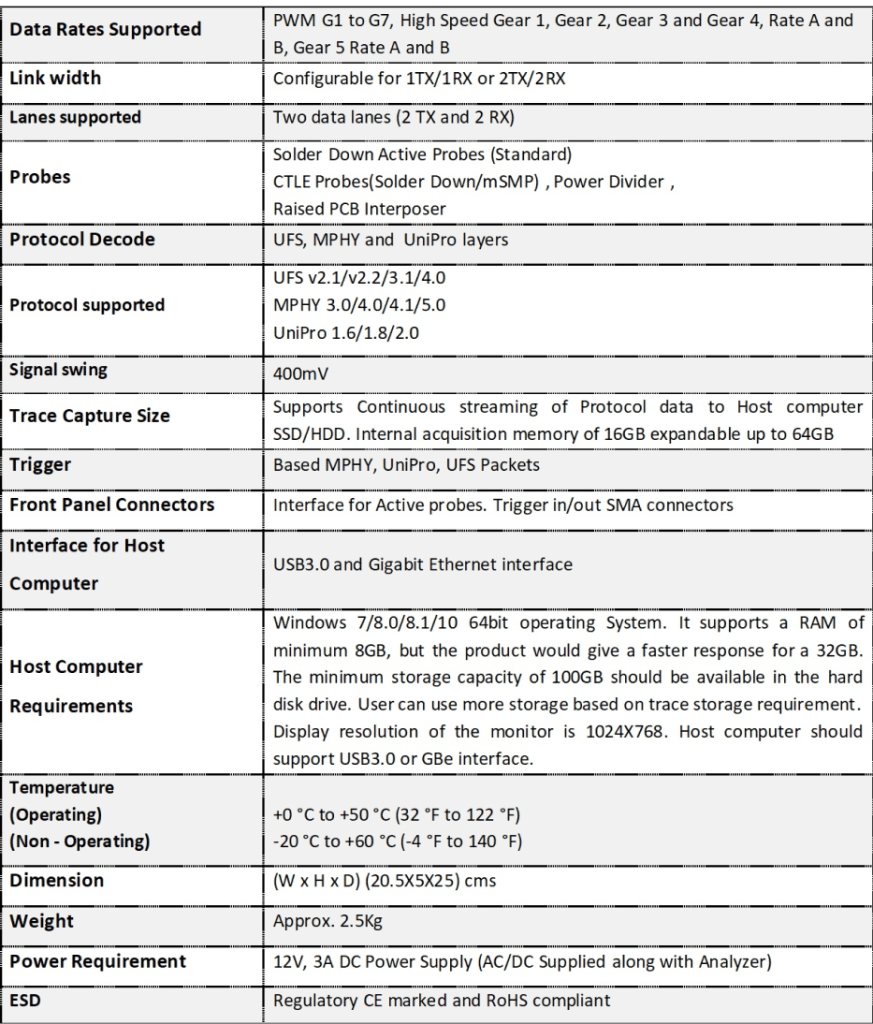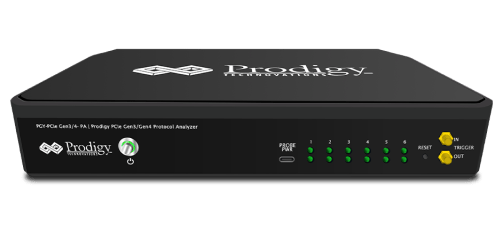



UFS 4.0 Protocol Analyzer
Product
Overview
Datasheet
Presentation
Application
Notes
PGY-UFS4.0-PA, UFS Protocol Analyzer is the industry-first working and tested UFS4.0 Protocol Analyzer. It offers protocol data capture and debugging of data across MPHY, UniPro, and UFS protocol layers. It allows for instantaneous decoding of UFS, UniPro, and MPHY layers with the flexibility to correlate decoded data across these protocol layers. PGY-UFS4.0-PA supports PWMG1 to HSG5B data rates and two TX, and two RX lane decode. The active probe has minimum electrical loading on the device under test (DUT) and captures protocol data without affecting the performance of DUT. PGY-UFS4.0- PA Protocol Analyzer supports two-lane data. Comprehensive on the fly decoding of UniPro & UFS data enables validation of communication between UFS host and device.
PGY-UFS4.0-PA Protocol Analyzer allows Design and Test Engineers to obtain deep insight into UFS host and device communication. MPHY/UniPRO/UFS packet-based triggering allows specific protocol data capture and analysis. PGY-UFS Protocol analyzer instantaneously provides decoding of UFS, UniPro, and MPHY layers with a correlation to MPHY, UniPro, and UFS layers.
SD, SDIO, eMMC Protocol Analyzer Datasheet
Key features
- Continuous monitoring of protocol data for a long time to capture elusive events (more than 30GB data capture)
- Analysis of captured data per standards for protocol integrity, count of data bursts, CMD CRC errors, Response CRC errors, Data CRC errors, Timing Values, and Reserved commands
- Hardware-based protocol-aware trigger capability in real-time enables capturing specific Events. Triggering facility on patterns, commands, or error events.
- Users can identify the anomalies by decoding command and response arguments
- Analytics feature provides analysis of acquired protocol data by plotting command, response, data, and frequency of operation over acquired time
- The analytics feature also provides the decoding of device registers for easy analysis
- Filters allow you to view specific packets in decoded protocol packets
- Search feature for specific events in protocol activity
- Easy-to-use user interfaces save time on the learning curve
- Handles long duration capture and displays the decoded data without demanding extensive resources in the host computer
- Inserting markers [using Trigger-In] in protocol activity helps in correlating the input digital signal with Protocol Activity
- Trigger-out signal for any specific protocol event allows triggering of other instruments such as oscilloscope
- Interface to host system [running UI] using USB3.0 or Gigabit Ethernet interface
- Flexibility to upgrade the hardware firmware using the GbE interface provides easy field up-gradation of firmware
- Export of Decoded data packets to txt file for further analysis
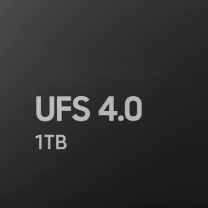

Setup

PGY-SSM Protocol Analyser works on the principle of fat-pipe analysis where the analyzer probes are connected on the interface bus between host and device[memory] of the unit under test. It captures all transactions that are going on between the host/device and does real-time analysis for errors + a detailed analysis of the captured data which is made available through UI running on a host system. Captured data is stored in the hard disk of the system running UI, enabling a long capture [expect to have enough free space in the hard disk]. PGY-SSM Protocol Analyzer interfaces to host using USB3.0 [Super Speed] and GbE. PGY-SSM analyzer & UI software runs in the host machine. PGY-SSM protocol analyzer also has the capability to capture boot data for eMMC.
Key Specifications
Specifications
Interfaces Supported | SD3.0 (UHS-I), SD104.0, and eMMC 4.41/4.51/5 0/5 1 Specifications |
Protocol Decode | Command, Response, CRC, Data, Boot Data, Arguments, Device registers |
Data Decode | 1 bit, 4 bit, 8 bit SDR, or 4,8 bit DDR |
Protocol Test | Protocol integrity, CRC Errors, Timing values, Data CRC Errors, Reserved commands |
Operating Voltage levels | 1.2V, 1.8V, 3.3V |
Storage Capability | Continuous streaming of protocol activity up to 30GB |
Capture Mode | Manual Run/Stop, Time-specific |
Capture Duration time | 1 sec to 5 hours |
Trigger on | Command, Response, CRC errors, Sequential trigger |
Trigger Actions | Capture data and/or trigger out signal |
Signal Input | Digital Signal input to mark the activities in Protocol activity |
Host System Interface | USB3.0 or Gigabit Ethernet (Gbe) interface |
Host Machine Minimum Requirements | Microsoft Windows 8, Windows 7, 16GB of RAM. Storage with at least 50 GB HDD space for storing the acquired data. Display with resolution of at least 1024×768 |
Probing
PGY-SSM Protocol Analyzer has an active probe, which provides very flexible probing with minimum electrical loading of DUT. This is specifically designed keeping to address challenges in probing eMMC/SD/SDIO signals. The probe supports 200MHz DDR bandwidth so that eMMC/SD/SDIO signals can be captured without any error. Probes have a flying probe lead set with a berg post connector and solder-able probe tips making it very convenient to connect to DUT.
Comprehensive Protocol Analysis
PGY–SSM Software provides the industry’s best protocol analysis capabilities. A simple-to-use interface reduces the complexities and time for protocol debugging. Time-stamped view of the decode listing provides a complete view of protocol activities between the host and device. By clicking on selection prompts, the user can get the decode of arguments, CSD, CID registers, data activities, and more [detailed view]
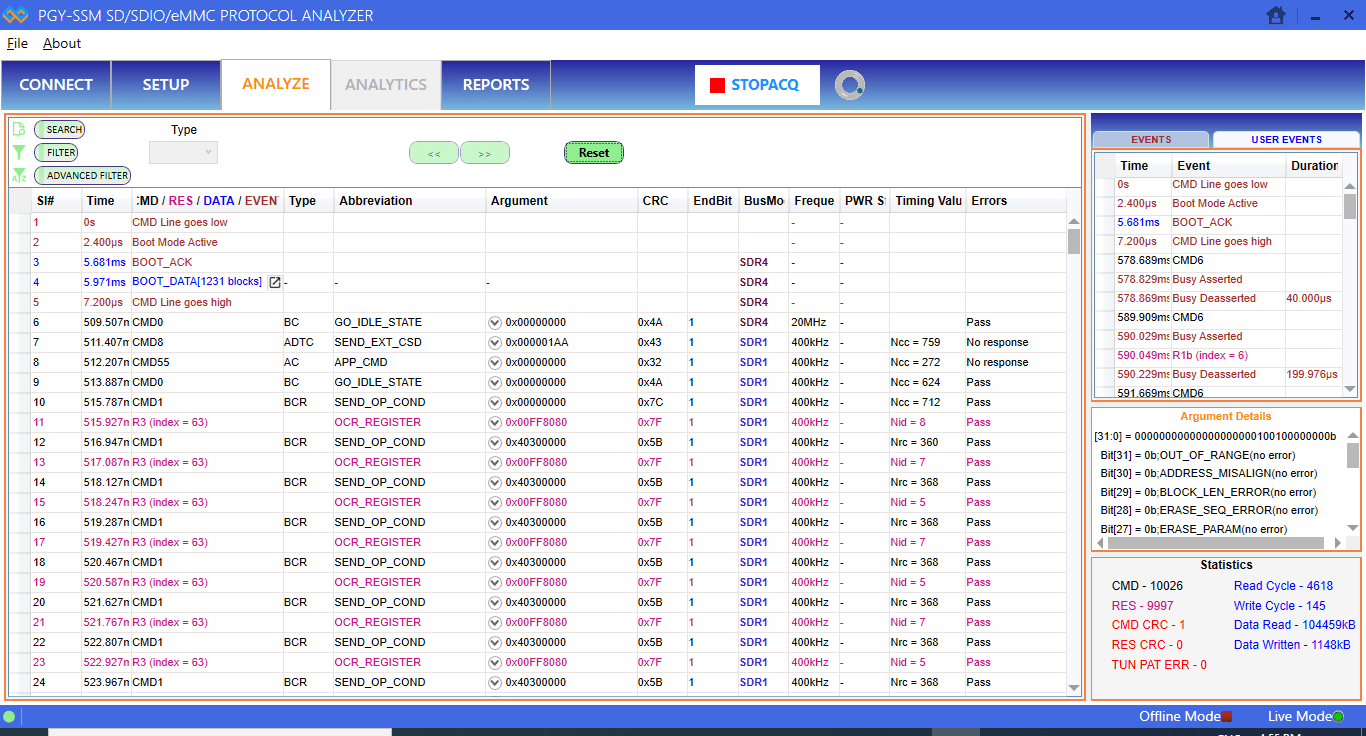
Protocol Data Capture and Trigger
PGY-SSM Protocol Analyzer has powerful protocol-aware trigger capabilities that allow the capture of protocol events at specific events. PGY-SSM supports simple and advanced trigger capabilities. PGY-SSM can trigger specific command, response, and CRC error conditions. Advanced trigger capabilities allow sequential trigger conditions to capture protocol data after a sequence of events. In Auto mode, data is captured by pressing the RUN button.
Protocol data capture duration is controlled by manual stop or setting the capture duration. Manual stop offers the flexibility of set protocol data capture by visual activities in DUT. In time duration user set data capture in secs to 3 to 4 hours. During the capture mode, protocol data is continuously streamed to the host system hard disk drive for storage.
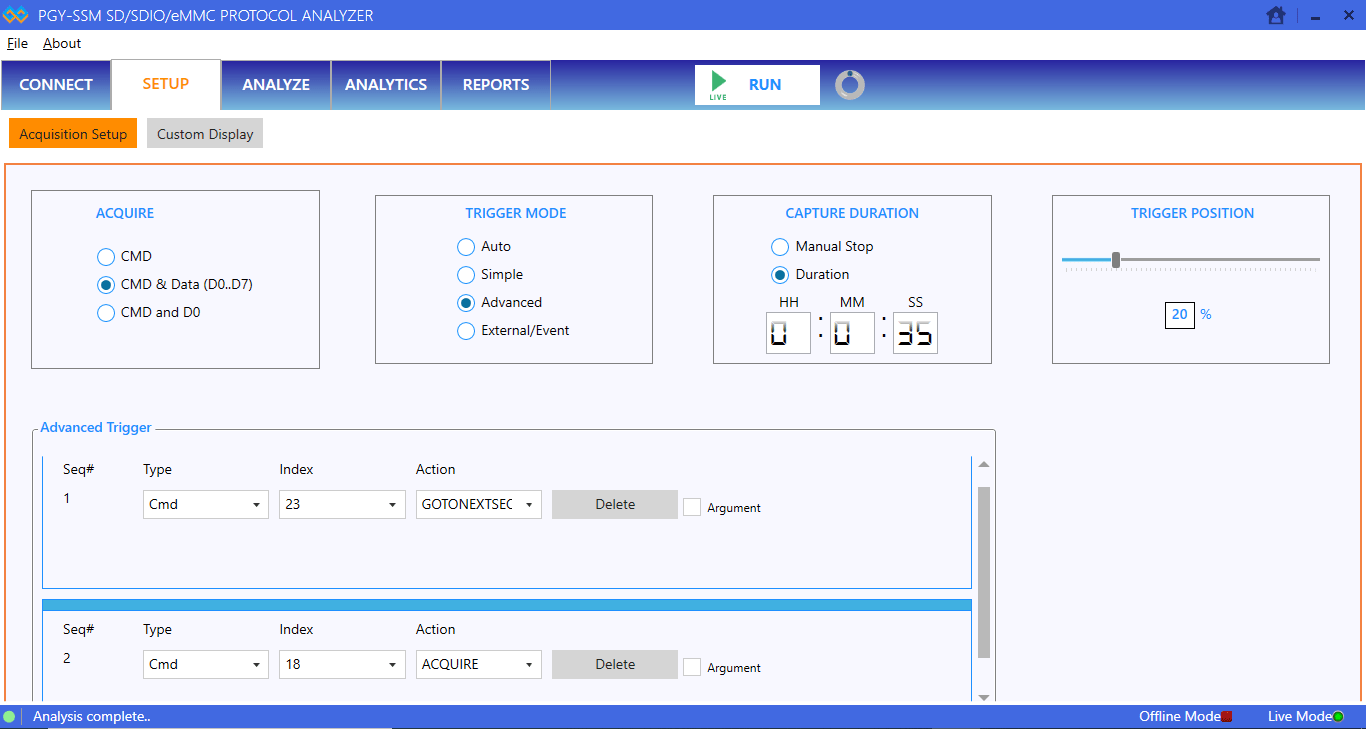
Analytics
1. Analytics features quickly provide insight into protocol activity without going through the complete protocol activity. An ample plot is shown below:
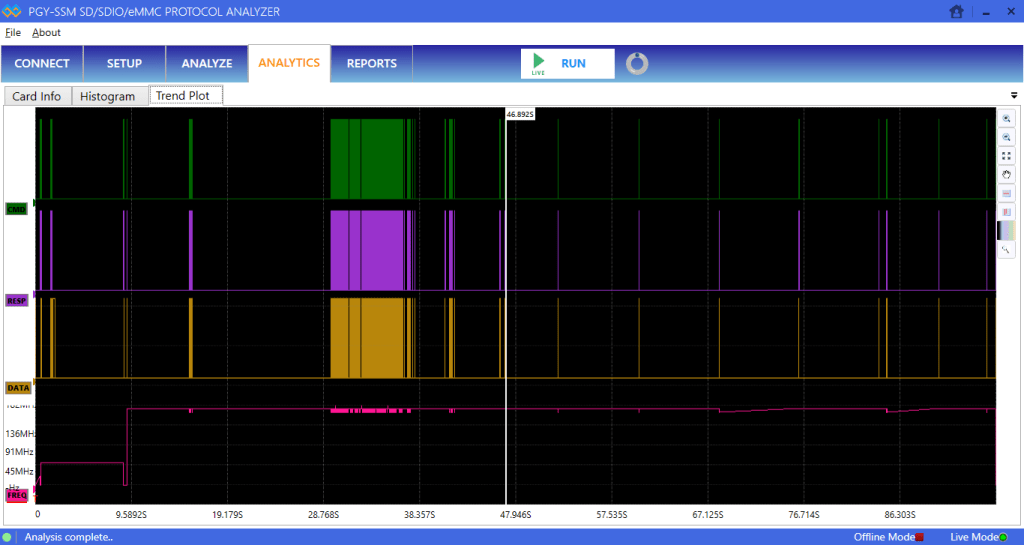
The Analytics view is a bird’s eye view of protocol activity for the captured long-duration data. It reduces analysis time by viewing plot command; response, data, and frequency of operation of captured data. The user can search for specific commands or responses in the plot.
Analytics
2. Card/Device Information provides decoding of register argument of device. Now the user no longer needs to manually decode each register value.
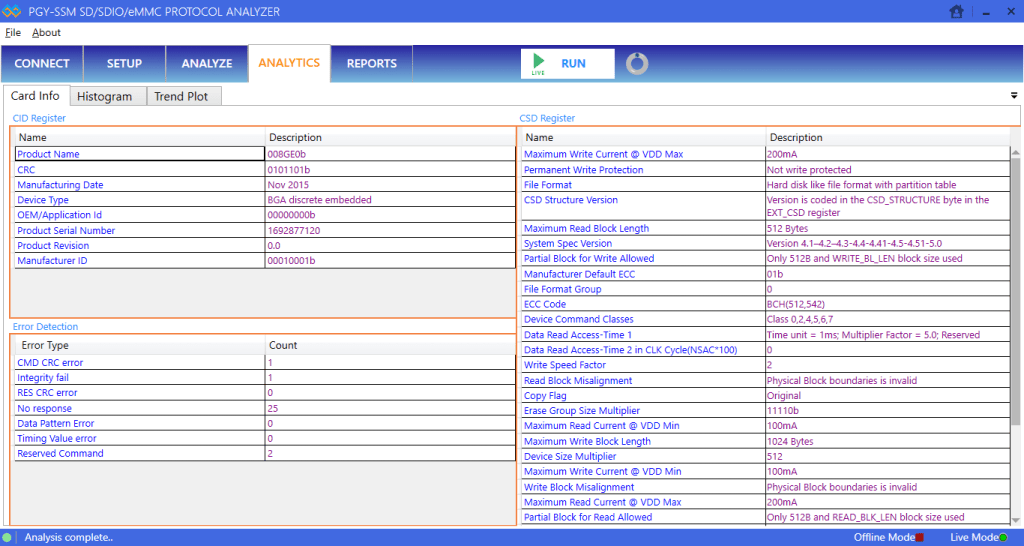
Host Machine Minimum Requirements: Microsoft Windows® 8, Windows 7, 16GB of RAM; Storage with at least 50 GB HDD space for storing the acquired data. Display with a resolution of at least 1024×768.
